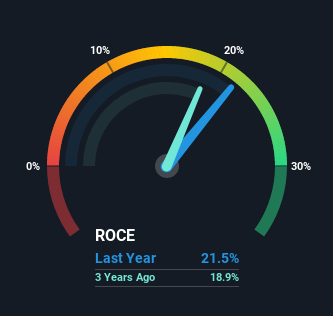- India
- /
- Metals and Mining
- /
- NSEI:GOODLUCK
Many Would Be Envious Of Goodluck India's (NSE:GOODLUCK) Excellent Returns On Capital

What are the early trends we should look for to identify a stock that could multiply in value over the long term? Typically, we'll want to notice a trend of growing return on capital employed (ROCE) and alongside that, an expanding base of capital employed. This shows us that it's a compounding machine, able to continually reinvest its earnings back into the business and generate higher returns. With that in mind, the ROCE of Goodluck India (NSE:GOODLUCK) looks attractive right now, so lets see what the trend of returns can tell us.
Return On Capital Employed (ROCE): What is it?
For those who don't know, ROCE is a measure of a company's yearly pre-tax profit (its return), relative to the capital employed in the business. The formula for this calculation on Goodluck India is:
Return on Capital Employed = Earnings Before Interest and Tax (EBIT) ÷ (Total Assets - Current Liabilities)
0.22 = ₹1.2b ÷ (₹11b - ₹5.8b) (Based on the trailing twelve months to September 2021).
So, Goodluck India has an ROCE of 22%. In absolute terms that's a great return and it's even better than the Metals and Mining industry average of 16%.
View our latest analysis for Goodluck India

Historical performance is a great place to start when researching a stock so above you can see the gauge for Goodluck India's ROCE against it's prior returns. If you're interested in investigating Goodluck India's past further, check out this free graph of past earnings, revenue and cash flow.
What Does the ROCE Trend For Goodluck India Tell Us?
We'd be pretty happy with returns on capital like Goodluck India. The company has consistently earned 22% for the last five years, and the capital employed within the business has risen 55% in that time. Now considering ROCE is an attractive 22%, this combination is actually pretty appealing because it means the business can consistently put money to work and generate these high returns. You'll see this when looking at well operated businesses or favorable business models.
On a separate but related note, it's important to know that Goodluck India has a current liabilities to total assets ratio of 51%, which we'd consider pretty high. This can bring about some risks because the company is basically operating with a rather large reliance on its suppliers or other sorts of short-term creditors. While it's not necessarily a bad thing, it can be beneficial if this ratio is lower.
What We Can Learn From Goodluck India's ROCE
In short, we'd argue Goodluck India has the makings of a multi-bagger since its been able to compound its capital at very profitable rates of return. And the stock has done incredibly well with a 273% return over the last five years, so long term investors are no doubt ecstatic with that result. So while investors seem to be recognizing these promising trends, we still believe the stock deserves further research.
One more thing: We've identified 3 warning signs with Goodluck India (at least 1 which shouldn't be ignored) , and understanding these would certainly be useful.
If you want to search for more stocks that have been earning high returns, check out this free list of stocks with solid balance sheets that are also earning high returns on equity.
New: Manage All Your Stock Portfolios in One Place
We've created the ultimate portfolio companion for stock investors, and it's free.
• Connect an unlimited number of Portfolios and see your total in one currency
• Be alerted to new Warning Signs or Risks via email or mobile
• Track the Fair Value of your stocks
Have feedback on this article? Concerned about the content? Get in touch with us directly. Alternatively, email editorial-team (at) simplywallst.com.
This article by Simply Wall St is general in nature. We provide commentary based on historical data and analyst forecasts only using an unbiased methodology and our articles are not intended to be financial advice. It does not constitute a recommendation to buy or sell any stock, and does not take account of your objectives, or your financial situation. We aim to bring you long-term focused analysis driven by fundamental data. Note that our analysis may not factor in the latest price-sensitive company announcements or qualitative material. Simply Wall St has no position in any stocks mentioned.
About NSEI:GOODLUCK
Goodluck India
Manufactures and supplies precision engineering and steel products in India.
Proven track record with adequate balance sheet.
Similar Companies
Market Insights
Community Narratives



